
Rare sight:‘Kalu Muwa’ spotted in Wilpattu
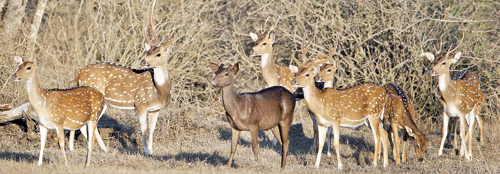 The ‘Black Spotted Deer’ amidst a herd of spotted deer. Pic by Kithsiri Gunawardena
The ‘Black Spotted Deer’ amidst a herd of spotted deer. Pic by Kithsiri GunawardenaIt was a single brief sighting of about 10 minutes at the Wilpattu National Park. But it was adequate for conservationist and photographer Kithsiri Gunawardena to be overjoyed.
For, what he saw was the ‘Black Spotted Deer’ or the ‘Kalu Muwa’ – a very rare melanistic Spotted Deer which he was able to photograph.
Here are Kithsiri’s notes:
“I received information from Mr. Seram who is an officer attached to the Department of Wildlife Conservation (DWC) of a black deer like animal that had been seen once or twice with a herd of Spotted Deer close to Pomparippu. No one was certain of the species of this strange animal as no one had seen such an animal in the wild. While some were of the opinion that it could be an immature sambhur, others wondered whether it is a hog deer. I had scheduled a field trip to Wilpattu from August 18-20 to engage in my study of leopards and other fauna and flora of the park and was quite keen to observe and photograph this strange animal.
“I spent three days at the park with Mr. D.M. Wasantha, a DWC guide, looking for this deer and was fortunate enough to have a single brief sighting one day of this uniquely coloured animal for about 10 minutes. Having examined the images, I was able to confirm that it is an extremely rare melanistic male Spotted Deer Axis axis.
“Melanism is the development of dark-coloured pigment, melanin, in the skin or its appendages and is the opposite of albinism, where the skin colour is white. While there have been a few records of albino mammals in the wild from Sri Lanka, melanistic animals such as the Black Leopard that was caught in an illegal snare in March 2009 from a village close to Deniyaya have been extremely rare.
“Spotted Deer are native to the Indian subcontinent. In Sri Lanka, they are found in the dry lowlands and are commonly seen in all the Dry Zone national parks. The upper parts of their skins are golden to rufous and are covered in white spots. The abdomen, rump, throat, insides of legs, ears and tail are all white. There are a few records of white coloured (albino) Spotted Deer in the past from our jungles, including the Wilpattu National Park where a water-hole is named as “sudu muwa wala” after an albino Spotted Deer that was seen in the early ’60s.
“Wilpattu is the largest and the oldest national park in the island with a unique cluster of breathtakingly beautiful water bodies which are referred to as Villus which support a multitude of species native to Sri Lanka. It is associated with the origins of the Sinhala race and holds so many places of archaeological importance. During my ongoing study, which began in 2011, I have so far recorded many species of fauna and flora including 208 species of birds, 31 species of mammals, 92 species of butterflies, 130 species of wild flowers and nine species of wild orchids from Wilpattu. My study of leopards has so far resulted in individually identifying and studying 76 different leopards. www.wilpattu.com
“This rare and unique specimen of the ‘Black Spotted Deer’ or ‘Kalu Muwa’ which has never been reported from any other park in the country is yet another reason for us to offer even greater protection to the Wilpattu National Park.”
Source – 27/08/2017, The Sunday times, See more at – http://www.sundaytimes.lk/170827/plus/rare-sightkalu-muwa-spotted-in-wilpattu-256101.html

Garbage crisis: Seoul searched and found a solution
Perched atop a hillock in Seoul, Korea, is the picturesque Sunset Park. It is resplendent in spring, with glorious bursts of flowers and foliage. Winter brings with it a peaceful serenity while families with children teem there in summer to camp on its grassy plains, play rounds of golf or catch butterflies. There is even an orchard, a vegetable plot and an herb garden.
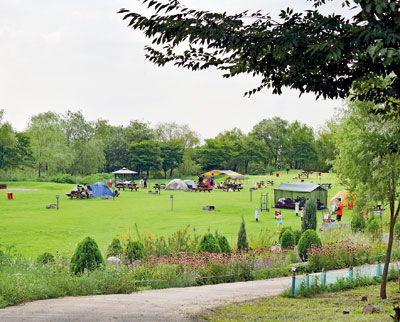
Camping at Sunset Park
It defies belief that this was once a landfill into which 92 million tonnes of garbage was dumped over a 15-year period. The slopes that sightseers stroll on are made entirely of rubbish. And here and there, methane pipes still rise from the ground while the area is constantly monitored as the garbage settles further with time.
Sunset Park–or ‘Neoul Park’ in Korean–is one of five that make up the World Cup Park in Sangamdong-gil, Seoul. They are arranged around the World Cup Stadium and were opened in May 2002, in time for the 17th FIFA World Cup hosted by Japan and Korea. This place was called Nanjido Island.
It wasn’t always so scenic. The landfill, which opened in 1978 and closed in 1993, stretched for 2.4 kilometres and was 98 metres tall. According to Korean urban planners, the absence of waste disposal sites led Nanjido to be turned into Seoul’s official dumpsite as it was easily accessible.
“Since this point, the once beautiful island with promising outlook slowly turned into land of death,” says Seoul Solution, a Seoul Metropolitan Government website. “From March 1978, trash began to be filled here, and in 1998, 28,877 tonnes of garbage was gushed [sic] out to the landfill site every day.” This went on till November 1992.
Serious environmental problems arose. Nanjido turned into a stinking mess that emitted harmful gases and effluents. The nearby Han River was badly affected while the air quality and ecosystem took a severe battering. So the Government devised a plan to transform the area into parks with views of Seoul.
This was a long-term, painstaking project that involved land stabilisation, topsoil levelling and soil recovery, leachate treatment, recycling of landfill gas and slope stabilisation. The project took many years to reach fruition and the results today are striking.
Some distance away is Incheon, a sprawling metropolis within which is located the world’s largest landfill site. The proposal here is to turn the massive dump, once it reaches maximum capacity, into a “Dream Park”. The whole operation is carried out by the Sudokwon Landfill Site Management Corporation (SLC) which, incidentally, helped Sri Lanka to build the Dompe sanitary landfill which was implemented with Korean International Cooperation Agency (KOICA) aid. That is just two hectares in extent. Sudokwon is 1,540 hectares.
When Nanjido was shut down, it was to this area that the Government shifted the waste of millions of inhabitants of Seoul. The local resistance to the plan is well-documented. Residents were fearful of air and water pollution, among other things. The authorities set up committees to allay their fears, opening the site up to inspections and monitoring by residents. After land-filling started, an operations committee was established along with a community support fund to improve the environment and quality of life in surrounding areas. Depositing of garbage kicked off in 1992. There was a learning process which led, today, to better methods of managing leachate, odour and other forms of pollution. The Government took a lead in most areas, even promulgating a law to set up the SLC as a public-private management body in 2000.
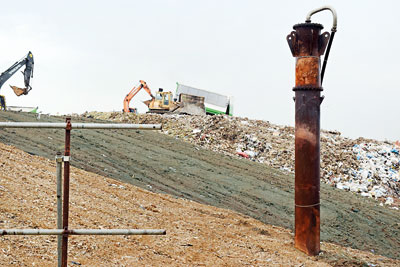
A layer of soil is applied every day over the garbage
Operations were centralised to avoid overlap and poor coordination among the metropolitan Governments of metropolitan area of Seoul, Incheon, and Gyeonggi-do. This way, waste management and civil complaints could be addressed in a harmonised manner. Without strong State backing, the project would not have been possible, authorities said.
Today, the adverse effects on the environment of the Sudkwon landfill are greatly reduced through sophisticated leachate and waste treatment techniques, says Hee Mun Lee, Deputy General Manager of SLC’s Climate Change Business Division. Mr Hee worked on the Dompe landfill site in Sri Lanka. Methane gas from buried garbage is used to generate energy which powers a turbine to generate electricity for the landfill site. This is now making profit.
Less lucrative is an ongoing initiative to turn garbage into combustible pellets which SLC then hopes to sell to private power generation firms. However, it is being continued as part of research and development. (Ten percent of all profits generated from operations at Sudokwon go towards the welfare of area residents).
At the same time as developing the Sudokwon site, the Government introduced a volume-based waste disposal fee which saw Koreans paying for the amount of waste they originated. Households and commercial entities have to buy designated bags to throw away their rubbish. Collection of recyclable waste is free. This caused a drop in the volume of garbage generated.
It was then decided to extend the lifetime of the Sudokwon site much beyond 2016, when it had been expected to reach capacity. This caused another spurt of protests from people who had expected the dumping to end on schedule. The dispute was recently resolved after it was agreed to hand ownership of the land to Incheon Metropolitan Government.
Today, rubbish is transported to the landfill site everyday in covered green trucks. Each time a layer of it is dumped, it is flattened by dozers and 0.2 metres of soil is laid on top of it. This happens every day and within five hours to prevent waste from dispersing, pests and foul odour from spreading and rainwater penetration.
The naturally-produced landfill gas (methane concentration of about 50%) is collected and transferred to a 50 megawatt power plant to simultaneously generate electricity and prevent foul odour. A cut-off wall on the bottom of landfill site prevents groundwater contamination and the leachate collected there goes to a treatment facility. Rainwater is removed through drains. Sterilizers and deodorizers are sprayed out while landfill waste treatment is underway. This includes smoke screen disinfection, road deodorization, upper-air deodorization and the sprinkling of water in surrounding areas.
The Sudokwon site has four sections. The first reached capacity and was closed in 2000. The second is receiving waste while the third is under preparation. The ultimate plan is to rehabilitate the whole area into Korea’s biggest eco-friendly park called ‘Dream Park’. The transformation is complete in the first section. Not only does it have a wildflower complex and a wetland observation zone, it boasts a soccer field, a basketball stadium and tennis courts and, of course, a public golf course.
(The writer’s visit was sponsored by the Korean Culture and Information Service to mark the 40th anniversary of diplomatic relations between Korea and Sri Lanka)

Covered garbage trucks arriving at the Sudokwon landfill site
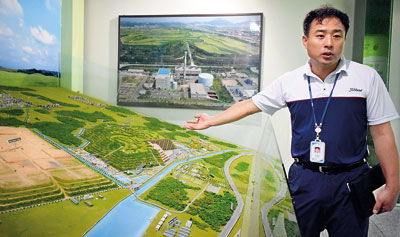
Mr Hee, pointing to a model of the world’s largest landfill site
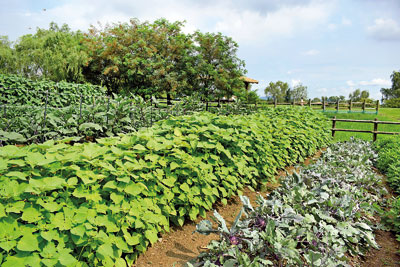
The vegetable and herb garden at Sunset Park
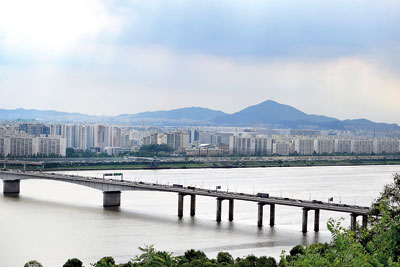
View of Seoul from Sunset Park
Source – 27/08/2017, The Sunday times, See more at – http://www.sundaytimes.lk/170827/news/garbage-crisis-seoul-searched-and-found-a-solution-256555.html

Drinking water scarce in drought hit Kilinochchi

People in the Kilinochchi District are finding it difficult to obtain drinking water due to the drought in the region.
The prolonged drought has also affected a large number of trees, including mango, jack and orange.
There is a huge demand for drinking water especially in the Ponnagar, Malayalapuram, Konavil, Unionkulam areas that come under the Karaichi Divisional Secretariat.
Water scarcity continues to prevail even though drinking water is provided to affected areas by the Disaster Management Centre.
People complain that they have to face various challenges to obtain drinking water.
The newly resettled families of Konavil and Unionkulam have planted coconut for their livelihood; however the prevailing drought weather condition has damaged those crops.
Source – 24/08/2017, Ceylon Today, See more at – http://www.ceylontoday.lk/article20170401CT20170930.php?id=6135

Artificial water tanks set up for wild animals to quench their thirst: State Minister
The artificial water tanks have been set up under the guidance of State Minister Palitha Ranga Bandara.
The State Minister’s project is being implemented with the help of Police officers, Wildlife Conservation officers, Forest Department officers and also with the help of the general public.
Due to the drought, the water level in these water storages and small water tanks (Villu) have decreased, while the wild animals face difficulties in quenching their thirst.
Accordingly, to overcome these difficulties faced by wild animals, small water tanks have been dug, while polythene had been spread inside the holes. Water has been pumped over the polythene by bowsers, while water tanks have been set.
http://www.dailynews.lk/2017/08/25/local/126260/artificial-water-tanks-set-wild-animals-quench-their-thirst-state-minister

Suspected treasure hunters caught inside wildlife park
Three suspects, including a junior Wildlife Officer have been taken into custody for allegedly engaging in treasure hunting inside the Lunugamvehera National Park.
Officers from the Lunugamvehera Office of the Department of Wildlife Conservation (DWC) launched a special operation this morning (24) to arrest poachers who were hunting animals inside the park during the drought season. They had spotted a jeep whose occupants were behaving suspiciously and attempted to inspect it. However, the jeep had driven away from the officers and exited the park.
Wildlife officers had given chase and fired on the tyres of the vehicle. With one of its tyres blown out by gunfire, the vehicle had come to a stop. Of the five occupants inside the vehicle, two had escaped while three others were captured and arrested.
The DWC officers said one of the arrested suspects was a teacher at a popular school in Matara while another was a junior officer attached to the DWC. The other was a resident of Tissamaharama.
Officers found another van used by the suspects, along with pooja equipment, food, water, cooking utensils, gas cylinders, digging tools and other equipment the suspects had brought with them for treasure hunting.
The arrested suspects are due to be produced before the Lunugamvehera Magistrate.
Text and Pix by Rahul Samantha Hettiarahchi in Hambantota
Source – 24/08/2017, Times Online, See more at – http://www.sundaytimes.lk/article/1030185/suspected-treasure-hunters-caught-inside-wildlife-park

Colombo University on an environmental mission
On April 14 (2017), when the man-made Meethotamulla garbage dump collapsed killing 31 people, the entire nation mourned. Environment experts aired their views on what to do and what not to do. Everybody blamed the politicians and as usual it became a political issue, with various parties being subject to blame. Compensation was paid and temporary solutions were found by moving residents from affected areas to a safer place. Meanwhile long term plans were discussed in Parliament to shift the garbage dump from Meethotamulla to Muthurajawela and Puttalam. Unfortunately the decision-makers hadn’t considered the impact on the environment when dumping garbage at Muthurajawela. Garbage shouldn’t be dumped at Muthurajawela for the sake of the environment.
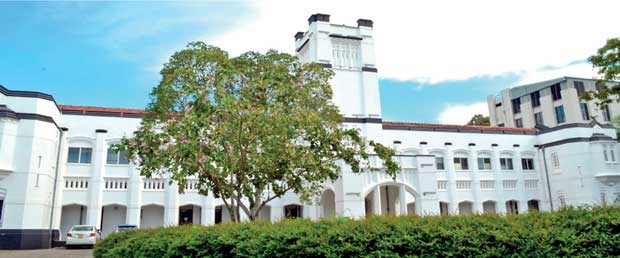
Floods in the South
Before dust the settled in Muthurajawela another calamity took place. This time the nature played havoc by causing continuous rains for three days. The rains led to floods, mainly in the South. Apart from the 202 deaths, the damage to properties and livelihood exceeded a couple of billion rupees. The entire country rallied round to support the victims. The corporate sector, the media and religious leaders played huge roles. One notable event was highlighted in the process. The students of the Jaffna University collected school books and visited the South, distributing them among the schoolchildren whose books were taken away by the floods. We shouldn’t forget that the mental wounds which were created by the war haven’t healed. These acts of kindness and generosity will be remembered for a long time. The Sri Lanka Army in Jaffna, under the leadership of Major General Mahes Senanayake (present Army Commander), played a huge role in organizing the travel of the undergrads from Jaffna to the South.
Dengue epidemic
Generally health issues crop up after a flood. This time the dengue has so far killed 350 people. More than 100,000 people have suffered from dengue. Unless quick action is taken, the number of deaths will rise. The dengue mosquitoes are flying all over the island and now this disease has become a national issue and is considered an epidemic. Given this situation the academic staff of the Department of Zoology and Environment Sciences of the University of Colombo, headed by Prof. Wipula Yapa and Prof. Mayuri Wijesinghewith, the blessings of the Vice Chancellor Prof. Lakshman Dissanayake and the Dean of the Science Faculty Prof. K. R. R. Mahanama, initiated a shramadanaya (A campaign where participants provide their services free) at the university premises on the 27th July 2017. Those who participated not only cleaned the premises, but also took an initiative to counter dengue with the use of medicinal plants. They were able to create an awareness on how the improper disposal of polythene and plastic can aid the spread of dengue. The entire Faculty of Science, the University of Colombo and School of Computing (UCSC) supported the shramadanaya.

Shramadanaya and BEEZ
Prof. Mayuri Wijesinghe, who organised the shramadanaya, received the support of all the students. Charuni Pathmeswaran was the link between the academic staff and the students. The Vice Chancellor provided a huge boost by deciding to close the Science Faculty at 1.00 pm so that students could take part in the shramadanaya. It’s rarely that the Science Faculty halts lectures unless it’s absolutely necessary. The newly elected student body of Base for Enthusiasts of Environment Sciences and Zoology (BEEZ) under the leadership of Amayaa Wijesinghe (President) sprung into action. They had obtained the medicinal plants for a symbolic tree planting session and also organised a specially designed picture postcard to carry the message ‘Say No to Polythene’. One star class hotel was kind enough to provide refreshments for all (300) participants. Kavinda De Zoysa, an Alumnus of the University of Colombo, donated plants while Sampath Bank sponsored the event.
Say no to polythene
Prof. Yapa who is the brainchild of the initiative ‘Say No to Polythene’ is heading the awareness campaign. Through this initiative he hopes to reduce the use of polythene and plastic. He has had several discussions with like-minded people to find answers to how a reduction can be made in the use of polythene and plastic. He is of the opinion that all super markets should charge a reasonable price from the customers for ‘Silisili Bags’ (Polythene bags) to discourage the use of polythene. For supermarkets to implement this the Government must intervene. Otherwise it won’t happen due to various reasons. At this very moment Prof. Yapa is conducting a research on how to produce a somewhat stronger paper bag at a low cost to replace polythene bags. He is also earmarking bank branch networks to promote the concept ‘Say No to Polythene’ among customers.

Medicinal Plants to Counter Dengue
The initiative taken to counter Dengue by using ‘Nature’s Friend’-the plants- is the brainchild of Prof. Deepthi Wickremasinghe. Wickremesinghe had discussions with Prof. Yapa to make a joint effort with the view of countering Dengue. Prof. Wickremasinghe has collected several scientific data and statistics from programmes initiated by the leading organizations in other parts of the world on mosquitoes and Dengue. Her findings have made others become aware of the importance of the local plants such as Daspethiya (Marigolds), Pangiri (Citronella), Sera (Lemon Grass), Heen Maduruthala (Holy Basil), Kuppamania (Catnip) etc. During the discussions she made it a point that these plants not only have the potential to repel mosquitoes, but also can contribute to the ‘Green Cover’ (even in the small way) and add value to the landscape (specially the use of Daspethiya).
Green University
The Vice Chancellor during his address to the students thanked Prof. Yapa, the academic staff and BEEZ for initiating such an important event (Say No to Polythene and Counter Dengue) and requested students to get more involved in University activities mainly for the benefit of the environment. He reminded the students how he spent forty years with the University of Colombo-first as a student, afterwards as a lecturer and now as the Vice Chancellor. He said that his goal is to turn the University of Colombo in to a ‘Green University’ by the year 2020. He has already started working towards realizing that goal. He requested students to protect the nature and the environment and help make the country a better place for future generations to live in. Prof. Mahanama, the Dean of the Science Faculty, in his address elaborated on the future plans of the university for the benefit of students. He requested them to obtain the maximum benefits from the facilities provided and work towards the betterment of the society. He also said that plans were being made to build three buildings to provide students with more facilities. He assured that none of the buildings will have a harmful effect on the environment.

Prof. Yapa in his speech thanked the Vice Chancellor and the Dean for playing an active part in the shramadanaya. He also thanked the academic staff and the students of the Science Faculty for extending their fullest cooperation to make the event a success. He highlighted the activities of the BEEZ, which is turning itself in to a beehive of activity. He also said that there are several environmental programmes in the pipeline and that they will be commenced within the next few months. He paid a tribute to AdeZ Sri Lanka (Link Children to the Nature) for joining hands with this shramadanaya campaign and requested them to continue the good work in the future too.
Mission of the Professors
It’s amazing to see how three university professors (Prof. Yapa, Prof. Mayuri and Prof. Deepthi) have taken initiatives to counter Dengue at low cost. Any person in Sri Lanka can implement these programmes in any part of the country. Sadly these professors aren’t prestigious award winners hence they won’t grab media attention. This writer humbly request the media (TV and Print) to interview them so that more information can be obtained from the learned professors for the benefit of the general public. Prof. Wijesinghe set up the momentum for the entire university by bringing together all the students and other members of the faculty body towards a worthy cause. Prof. Wickremesinghe has already started her campaign with the students using medicinal plants. They hope to plant trees in 50 schools in the Colombo District. Prof. Yapa launched his campaign ‘Say No to Polythene’ with a specially designed picture postcard. The first card was presented to the Vice Chancellor just before the shramadanaya. Whoever who buys a card will pledge to reduce the consumption of polythene. All proceeds from the sale of cards will go to implement the green programmes, organised by the BEEZ.
The University of Colombo is one of the best or perhaps the best university in the country. The students are given the freedom to implement programmes under the guidance of a lecturer without compromising on their studies. Despite loads to study, the undergrads of the University of Colombo are committed to complete their mission. However, for this they need the support from all quarters. Any long journey has to start with the first step. ‘Say No to Polythene’ started in July this year. As President Kennedy once said, “It may take one day, one year or one hundred years to complete, but the main thing is to start”. Forty years ago, when we were youth, practically every youth smoked cigarettes for fun, but it is not so now. They are aware of the repercussions. There is also a political will to stop smoking and the authorities have specified the penalty if a citizen is caught smoking in public. Polythene consumption can be reduced by educating the general public, but Government support is a must.
Save the nature and environment
If we don’t act now and save the environment, we will be forced to learn lessons on damaging the environment by paying a heavy price. Global warming has come to stay. No one needs to mention that it’s an unwelcome guest. We aren’t that blind not to observe the repercussions of climate change and global warming. Danger signals are already present and as adults we have a moral duty to work towards saving the environment. If we fail in our attempts the future generation will curse us for not protecting the nature and the environment. The time has come to give back what we owe Mother Lanka. All the polythene and plastic that we have used so far and what we are going to use in the future will remain for centuries (except for biodegradable ones) though our average lifespan is between 70-75 years. How can we justify what we have done to the environment by using polythene and plastic? At least now there is some hope due to the awareness initiated by the University of Colombo. It should not be their mission only, but ours too.
Source – 25/08/2017, DailyMirror, See more at – http://www.dailymirror.lk/article/Colombo-University-on-an-environmental-mission-135331.html

Bolgoda Lake undemarcated even after survey: Environmentalists
Environmental organisation ‘Dalthara Parisarikayo’ says the Bolgoda Lake and its surrounding natural reserve in the East Gramaseva Division of the Kesbewa Secretariat remain undemarcated even after surveying the area as ruled by the Court of Appeal.
Dalthara Parisarikayo Secretary Nilupul Kahapolaarachchi said their organisation strived for many years to protect the Bolgoda Lake and it was able to obtain a court order to demarcate the natural reserve and undo the unauthorised filling of land in the area.
After the survey, an area of eight acres of illegally filled land within the stretch of one-and-a-half kilometres was identified.
However, the officials have not taken steps to acquire these lands or even to mark them, thereby depriving the residents of the opportunity to use the river for their day-to-day needs. This has also left the river to shrink gradually.
“This environmental devastation around the Bolgoda Lake is a result of the illegal activities of businessmen who run tourist hotels and leisure resorts with the support of politicians,” Mr. Kahapolaarachchi said.
A patron of the organisation, Professor P.M. Bandaranayake, too expressed similar sentiments.
“Dalthara Parisarikayo is not an organisation confined to secure the environment around the Bolgoda Lake. Its members are active environmentalists. As a result of our efforts, we have been able to get a court order to engage officers of relevant government institutes including the Survey Department to secure the Bolgoda environmental zone. However, this process has come to a standstill because of the protest of the users of reclaimed land. Also, the said survey is now being carried out in Bandaragama, but such protests are not shown in the area,” he said.
Meanwhile, those opposing the survey claim that the surveying had been done based on a map planned in 1817.
However, an official of the Central Environment Authority who was involved in the survey refuted this argument saying the survey was done based on a tracing prepared in 2001 on a 1962 survey of all the river basins of the country by a Canadian institute at the request of the Sri Lankan Government.
When asked about the reasons for not installing survey stones in the area, Survey General P.M.P. Udaya Kantha said their survey was accurate and they applied same methods of surveying any part of the country, but had to stop installing surveying stones temporarily due to protests raised by several land owners.
Source – 25/08/2017, Mirror Citizen, See more at – http://mirrorcitizen.dailymirror.lk/2017/08/22/bolgoda-lake-undemarcated-even-after-survey-environmentalists/

Cabinet paper now pushes Jumbos from pillar to post

Elephas Maximus Maximus or the Sri Lankan elephant in other words has a closer relationship with us Asians. As depicted in Hindu mythology, the much revered elephant-headed God, Ganesh, itself highlights the importance of this majestic being. Over the years we have been delighted to see elephants in pageants (peraheras), but not once have we thought of the troublesome experiences these majestic beings have to endure. As a result little do we know about how these animals have been exploited during various instances.
In a controversial turn of events, an unexpected overcrowding of elephants at the Pinnawala Elephant Orphanage has prompted the Government to giveaway elephants to private individuals and institutions. Following this, a cabinet paper too was dispatched to release 33 cubs back to their owners. These cubs had been illegally captured from the wild. The Daily Mirror spoke to several individuals of varied expertise in the field of wildlife, thus shedding light on the darker side of this issue.
Highlights of the cabinet paper
Recently a cabinet paper was issued with a request being made to give away elephants cared for at the Pinnawala Elephants Orphanage and National Zoological Gardens.
The highlights of the paper are:
- Elephants from the Pinnawala Orphanage were used as the ‘stock of elephants’ to be presented as ‘State gifts to other countries’ and to religious institutions and individuals in the country by the ‘Head of the State’.
- However, the maintenance of the present number of elephants (88) in a restricted land area of 27 hectares has become a difficult task.
- The temperament of individual animals vary, when male animals come in to ‘musth’ their maintenance and attention become difficult as numbers increase.
- Further, the global campaign to house captive animals without chains (chainless animal populations) is effecting the tourist visitation negatively and the image of Pinnawala is also being tarnished.
- Considering these factors it has become very clear that some animals will have to be given out to ensure that the captive population is maintained within the ‘carrying capacity’ of the facility.
The request therefore was to give away elephants with a ‘non-refundable financial bond’ of Rs. 10 million. However the cabinet paper also states the following; “The animals are NOT sold to individuals or institutions as elephants in accordance to the Fauna and Flora Protection Ordinance amended in 2009, Section 22A (12) are ‘deemed to be public property’. Thus they are given to be cared ‘for and on behalf of the State’.

“I dispute the fact that Pinnawala is overcrowded”
–Dr.Sumith Pilapitiya
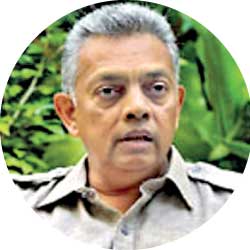
Speaking to the Daily Mirror, Environmental Specialist and Ex-Wildlife Chief, Dr Sumith Pilapitiya said that the Government has released a cabinet paper requesting the release of elephants due to overcrowding in Pinnawala. “This too is for a sum of Rs. 10 million. I would dispute the fact that Pinnawala is overcrowded and if overcrowding is the problem, there is a land adjoining the Pinnawala Elephant Orphanage which could be used as well. If not, some elephants could be sent to the Ridiyagama Safari Park because that too comes under the Zoological Department. The ownership and custody of these elephants should remain with the Government. Why do private individuals or institutions need to own elephants? There’s nothing called a domesticated elephant. Unlike cats and dogs, that are bred to be domesticated, elephants can’t be domesticated. These private owners are trying to own elephants as a status symbol. Elephants are very social animals,” said Dr.Pilapitiya who has spent a number of years researching on this majestic being.
“So once they are taken out of Pinnawala, they will have no social interaction because that elephant is now alone. Pinnawala has one of the best elephant breeding programmes and breeding can’t happen just because there’s a male and a female elephant. They need to have space for interaction as well. We need to think of what is best for the elephant. It’s time that we look at this situation in Sri Lanka in a more realistic way. Take the pageant for example. We didn’t have elephants at these processions till the rise of the Kandyan Kingdom. Therefore the Government should seriously think why temple processions need elephants. Today we see elephants in even small pageants done for a ‘katina’ (A religious ceremony) as well. Hence the Government has the added task of legally catering to this demand. Elephants in pageants are not a religious requirement because Lord Buddha never said that there should be elephants in a pageant. Therefore the Minister and the relevant authorities should look at this issue in a more practical manner. Now it’s time that these measures are implemented,” Dr.Pilapitiya said.
‘Giving ownership of elephants to private individuals reflects badly on the law’ – Jagath Gunawardena

“The entire decision is wrong,” said Jagath Gunawardena, environmental lawyer and wildlife enthusiast. “Their intention is to give these elephants back to illegal owners and these actions reflect badly on the law. Elephants are public property and once these elephants are handed over to owners, nobody will abide by the law. Hence it’s giving a wrong message to the country. I also don’t believe that Pinnawala is overcrowded because there are no facts or statistics to prove it. If that is the case, then why can’t they send these elephants elsewhere?”questioned Gunawardena.
“Individual owners will not have 100% ownership”
– Gamini Jayawickrama Perera
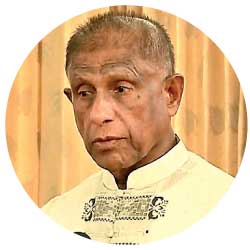
Wildlife and Sustainable Development Minister, Gamini Jayawickrama Perera said that since two Non-Governmental Organisations (NGOS) have filed cases with regard to this issue, the decision is still pending. “Although the cabinet paper says Rs. 10 million, it is a rough estimate.
However, the individual owners won’t have 100% ownership of the elephant. They have to sign a deed and officially take the ownership of the elephant and if we find out that the elephant is being ill-treated we have the authority to take it back,” said Perera.
‘Elephants are public property’ -Rukshan Jayawardene

Airing his views to the Daily Mirror, Wildlife and Nature Protection Society (WNPS) President and wildlife enthusiast Rukshan Jayawardene said that as much as elephants are protected under the Flora and Fauna Protection Ordinance, they also become public property at times. “Private individuals need elephants because it’s a prestige symbol. Elephants are living sentient beings, but unfortunately, protection is limited to the statute books. Also what is overpopulation? If there are more leopards, bears and elephants we need to protect them because they are our natural resources. Why should they be given to private owners? Can we be sure that the elephant will be treated well? Once the elephant is in the custody of a private owner, there’s a high tendency of it being smuggled as well. If these individuals could pay Rs. 10 million for an elephant, how many more bucks would they need to keep the Department of Wildlife Conservation (DWC) and other authorities away? This is more like a mafia because these people still have connections with those who are in power and those who were. Back in the day elephants were trained to build tanks and other massive structures, but at this day and age of industrialisation we don’t need elephants for these purposes and therefore they shouldn’t be kept in captivity. So this is a wake-up call for the Government. Hope this issue doesn’t fall on deaf ears,”said Jayawardene.
The plight of Elephas Maximus Maximus
In an investigative video released a couple of weeks ago by LT Magazine – a Sri Lankan magazine that highlights matters of human interest- revealed the plight of the Sri Lankan elephant. A team of wildlife enthusiasts including Dr.Sumith Pilapitiya, Rukshan Jayawardene, Dr.Prithiviraj Fernando – Chairman, Centre for Conservation and Research, Dr. Eric Wickramanayake, Chair and Science Advisor, Environmental Foundation Limited (EFL) and OtaraGunawardena, Founder of Otara Foundation pooled in their concerns. Some of the highlights of these concerns are:
- The Human Elephant Conflict is a human created problem because most HEC mitigation methods are confrontational and leads to more aggression of elephants towards people.
- Reckless driving of safari-goers.
- “Salaries of DWC officers aren’t enough and they work 24 hours. I need more people,” says subject minister.
- Other Ministries create problems and expect this ‘poor’ Government department to solve the issues.
- Udawalawe National Park, once an elephant sanctuary, doesn’t seem to be one anymore. The video further highlights how the elephants are trapped in due to fencing and are starving to death.
- As a result cattle have encroached on this land and are feeding on the grass. According to the Minister, once cattle feed on grass the entire plant is removed. Therefore the grass has to be regenerated again and for that the cattle have to be removed first.
- Elephants in the wild are given a low value and that is why people think that they are better off being captured for our own purposes.
- Dr.Sumith further states that if an elephant is used in a Buddhist or other religious procession, then the elephant has to be taken care of compassionately and the elephant’s welfare has to be taken in to consideration.
- Ven. Pahiyangala Ananda Sagara Thera emphasizes on how elephants suffer due to ill-treated by mahouts.
- Orphaned elephants that came in to the custody of the DWC were sent to the Zoological Department which opened up an elephant orphanage to release them back in to the wild, but that never happened.
- Elephants in Sri Lanka undergo Dominance-based training, where people get their tasks done through coercive means.
- Trading elephants is illegal in Sri Lanka.
For more information watch the video at:https://www.facebook.com/LifeTimesSL/videos/1898110206872522/
The Daily Mirror also learns that a request has been made to release 16 elephants provided that permit holders place a guarantee worth Rs. 10 million. The request is valid till September 20. However, attorney-at-law Sujeewa Jayasinghe further said that elephants with permit numbers 203, 209 and 231 will not be released.
Source – 24/08/2017, DailyMirror, See more at – http://www.dailymirror.lk/plus/article/Cabinet-paper-now-pushes-Jumbos-from-pillar-to-post-135310.html

Meepe: another Uma Oya disaster?

The Seethawaka Environmental Protection Association states that the villagers of Padukka, Meepe are being subjected to much distress owing to the rock quarries that are in operation on the Kithul Kanda rock.
A representative of the Association, Indika Wickramasinghe states that an entire side of the rock has by now been either blasted off or removed.
This large-scale mining activity and its consequent environmental damage have reportedly been going on for the past 4 years.
The quarries are said to be primarily supplying rocks and minerals for the Port City project.
The residents of the surroundings are now suffering from a shortage of drinking water, owing to the drying up of catchment areas; a consequence of the Kithul Kanda exploitation.
Indika Wickramasinghe explained that the pH level of the water had also been affected due to contamination with various chemicals.
Furthermore, the operation of the quarries has contributed to severe noise pollution, he added.
Wickramasinghe proceeded to state that that the dust particles added to the atmosphere had resulted in a high incidence of respiratory tract diseases among the populace.
16 rock quarries are currently said to be in operation across a region of about 3.5 square kilometres.
With the involvement of environmental organizations, protests had been launched in March 2017, demanding the termination of the unlawfully functioning quarries.
Although the quarries’ functions had temporarily been halted following the protests, 15 of the quarries had been regranted with permits, once again subjecting the citizens to hardship and distress.
Wickramasinghe pointed out that heavy rains, coupled with the intense mining, had resulted in landslides as well, putting the lives of human beings at risk.
He stated that no comprehensive assessment had been made prior to the issuing of permits by the Geological Survey and Mines Bureau.
Accordingly, he urged the authorities to take action and prevent the continuation of the aforementioned quarries which cause significant damage to both the environment and the villagers.
Chief Incumbent of the Sri Poorwarama Maha Viharaya of Uthumpe, Ven. Mahagama Hemathilaka Thero, in response to an inquiry made by Ada Derana, also reiterated Indika Wickramasinghe’s request from the authority to provide an immediate solution to the villagers suffering from the numerous problems caused by the exploiting of the Kithul Kanda rock in Meepe.
Source – AdaDerana, See more at – http://www.adaderana.lk/news/42617/meepe-another-uma-oya-disaster
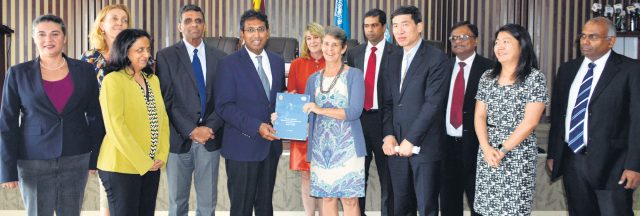
Sustainable Development Framework signed
The Government and the United Nations signed the 2018 – 2022 UN Sustainable Development Framework (UNSDF), the agreement which pegs UN assistance to Sri Lanka’s long term development priorities, on Thursday (3).
The UNSDF provides the overarching framework for the work of the United Nations in Sri Lanka in line with the national priorities of the Maithri Palanayak, Sthaavara Ratak: A Compassionate Governance, A Stable Country, the Public Investment Programme, the 2030 Agenda for Sustainable Development and the Sustainable Development Goals. The UNSDF was signed by M. I. M. Rafeek, Secretary, Ministry of National Policies and Economic Affairs and Ms. Una McCauley, UN Resident Coordinator and UNDP Resident Representative in the presence of Deputy Minister of National Policies and Economic Affairs, Dr. Harsha De Silva, and UN ASG, UNDP Regional Director and chair of the Regional UN Development Group, Haoliang Xu, along with representatives of the UN Country Team.
Speaking on the Framework Xu stated “The UNSDF will support the Government to achieve peaceful, just, inclusive and sustainable development with a special focus on leaving no one behind and reaching the furthest behind first.”
Elaborating on the UNSDF, Dr. De Silva, said “We are extremely pleased that the UN will be investing over USD 300 million for the development of Sri Lanka over the next 5 years. The 4 strategic areas of the framework; improved data, innovative public institutions, social security and resilience to climate change and disaster and especially evidence based policy planning are extremely important for the development of Sri Lanka.”.
The UN Country Team in Sri Lanka worked in collaboration with the Government, and in consultation with civil society and development partners, to ensure that the framework is grounded in the realities of the country. The UNSDF serves as a common strategy in four strategic areas of focus; towards improved data, knowledge management and evidence based policy; strengthened, innovative public institutions and engagement towards a lasting peace; social security and socio economic resilience; and enhancing resilience to climate change and disasters and strengthening environmental management.
The UNSDF will guide the collaborative work of UN agencies for 2018 – 2022 and support national efforts to reduce disparities and make a positive difference in the lives of all people.
Source – Nation, See more at =- http://nation.lk/online/2017/08/05/sustainable-development-framework-signed.html









